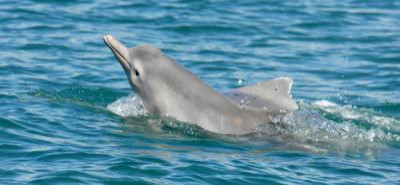New Dolphin Species Discovered Off Australian Coast [PHOTOS]

Researchers have identified a new species of humpback dolphin off the coast of Australia. The discovery ends a long-standing dispute over how many species of humpback dolphin exist in the wild.
Scientists from the New York-based Wildlife Conservation Society, or WCS, used genetic testing and physical comparison to identify the new species of marine mammal living off Australia’s coast. The dolphin, a member of the family of humpback dolphins characterized by their elongated dorsal fins and conspicuous humps, has yet to be named. The discovery brings the number of species in the humpback dolphin family to four.
"Based on the findings of our combined morphological and genetic analyses, we can suggest that the humpback dolphin genus includes at least four member species," Dr. Martin Mendez, assistant director of WCS's Latin America and the Caribbean Program and lead author of the study, said in a statement. "This discovery helps our understanding of the evolutionary history of this group and informs conservation policies to help safeguard each of the species."
Mendez and his team collected physical evidence from a number of beached dolphins and museum specimens. According to Science Daily, researchers studied the shapes of 180 skulls to compare the shapes of the dolphin craniums across the region.
Additionally, scientists collected 235 tissue samples from animals all over the eastern Atlantic and into the western Pacific. They looked at both the mitochondrial DNA and nuclear DNA for variations between the populations of dolphin.
Humpback dolphins are coastal dolphins found along the coasts of Africa, India and Australia. Adults can reach up to 8 feet, 6 inches in length, and weigh between 220 and 306 pounds.
According to The Washington Post, humpback dolphins are considered “vulnerable” in some parts of the world and “threatened” in other waters. Fishing and invasion of habitat are key factors affecting humpback dolphin populations globally.
"New information about distinct species across the entire range of humpback dolphins will increase the number of recognized species, and provides the needed scientific evidence for management decisions aimed at protecting their unique genetic diversity and associated important habitats," Dr. Howard Rosenbaum, director of WCS's Ocean Giants Program and senior author on the paper, said in a statement.
The discovery of a new species of dolphin off the coast of Australia isn’t the first new species of dolphin identified in recent history. In 2011, scientists identified the Burrunan dolphin in Port Phillip Bay near Melbourne as an entirely new marine mammal. The Burrunan dolphin, named for an Aboriginal phrase that means “large sea fish of the porpoise kind,” is chubbier than the average bottle nose dolphin, and has a shorter nose.
© Copyright IBTimes 2024. All rights reserved.






















